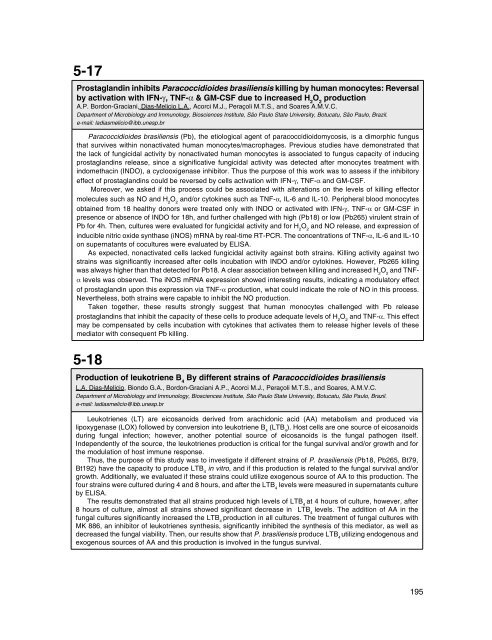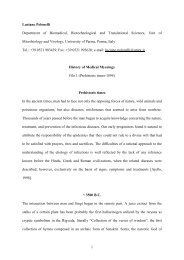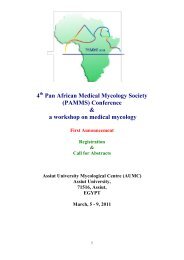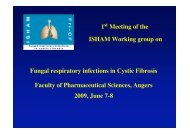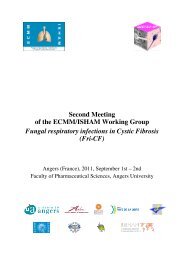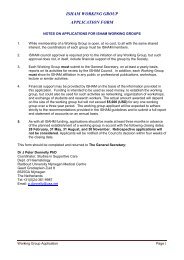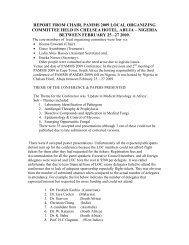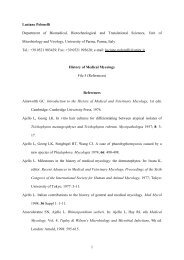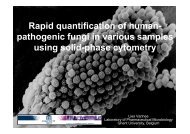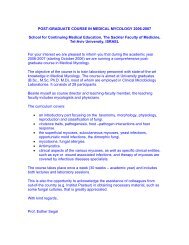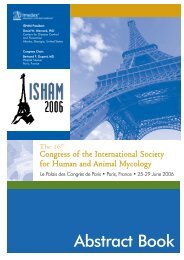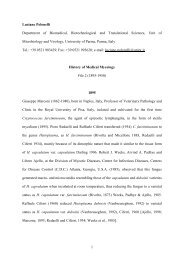Memoria CD.indd - ISHAM
Memoria CD.indd - ISHAM
Memoria CD.indd - ISHAM
You also want an ePaper? Increase the reach of your titles
YUMPU automatically turns print PDFs into web optimized ePapers that Google loves.
5-17Prostaglandin inhibits Paracoccidioides brasiliensis killing by human monocytes: Reversalby activation with IFN-γ, TNF-α & GM-CSF due to increased H 2O 2productionA.P. Bordon-Graciani, Dias-Melicio L.A., Acorci M.J., Peraçoli M.T.S., and Soares A.M.V.C.Department of Microbiology and Immunology, Biosciences Institute, São Paulo State University, Botucatu, São Paulo, Brazil.e-mail: ladiasmelicio@ibb.unesp.brParacoccidioides brasiliensis (Pb), the etiological agent of paracoccidioidomycosis, is a dimorphic fungusthat survives within nonactivated human monocytes/macrophages. Previous studies have demonstrated thatthe lack of fungicidal activity by nonactivated human monocytes is associated to fungus capacity of inducingprostaglandins release, since a significative fungicidal activity was detected after monocytes treatment withindomethacin (INDO), a cyclooxigenase inhibitor. Thus the purpose of this work was to assess if the inhibitoryeffect of prostaglandins could be reversed by cells activation with IFN-γ, TNF-α and GM-CSF.Moreover, we asked if this process could be associated with alterations on the levels of killing effectormolecules such as NO and H 2O 2and/or cytokines such as TNF-α, IL-6 and IL-10. Peripheral blood monocytesobtained from 18 healthy donors were treated only with INDO or activated with IFN-γ, TNF-α or GM-CSF inpresence or absence of INDO for 18h, and further challenged with high (Pb18) or low (Pb265) virulent strain ofPb for 4h. Then, cultures were evaluated for fungicidal activity and for H 2O 2and NO release, and expression ofinducible nitric oxide synthase (iNOS) mRNA by real-time RT-PCR. The concentrations of TNF-α, IL-6 and IL-10on supernatants of cocultures were evaluated by ELISA.As expected, nonactivated cells lacked fungicidal activity against both strains. Killing activity against twostrains was significantly increased after cells incubation with INDO and/or cytokines. However, Pb265 killingwas always higher than that detected for Pb18. A clear association between killing and increased H 2O 2and TNFαlevels was observed. The iNOS mRNA expression showed interesting results, indicating a modulatory effectof prostaglandin upon this expression via TNF-α production, what could indicate the role of NO in this process.Nevertheless, both strains were capable to inhibit the NO production.Taken together, these results strongly suggest that human monocytes challenged with Pb releaseprostaglandins that inhibit the capacity of these cells to produce adequate levels of H 2O 2and TNF-α. This effectmay be compensated by cells incubation with cytokines that activates them to release higher levels of thesemediator with consequent Pb killing.5-18Production of leukotriene B 4By different strains of Paracoccidioides brasiliensisL.A. Dias-Melicio, Biondo G.A., Bordon-Graciani A.P., Acorci M.J., Peraçoli M.T.S., and Soares, A.M.V.C.Department of Microbiology and Immunology, Biosciences Institute, São Paulo State University, Botucatu, São Paulo, Brazil.e-mail: ladiasmelicio@ibb.unesp.brLeukotrienes (LT) are eicosanoids derived from arachidonic acid (AA) metabolism and produced vialipoxygenase (LOX) followed by conversion into leukotriene B 4(LTB 4). Host cells are one source of eicosanoidsduring fungal infection; however, another potential source of eicosanoids is the fungal pathogen itself.Independently of the source, the leukotrienes production is critical for the fungal survival and/or growth and forthe modulation of host immune response.Thus, the purpose of this study was to investigate if different strains of P. brasiliensis (Pb18, Pb265, Bt79,Bt192) have the capacity to produce LTB 4in vitro, and if this production is related to the fungal survival and/orgrowth. Additionally, we evaluated if these strains could utilize exogenous source of AA to this production. Thefour strains were cultured during 4 and 8 hours, and after the LTB 4levels were measured in supernatants cultureby ELISA.The results demonstrated that all strains produced high levels of LTB 4at 4 hours of culture, however, after8 hours of culture, almost all strains showed significant decrease in LTB 4levels. The addition of AA in thefungal cultures significantly increased the LTB 4production in all cultures. The treatment of fungal cultures withMK 886, an inhibitor of leukotrienes synthesis, significantly inhibited the synthesis of this mediator, as well asdecreased the fungal viability. Then, our results show that P. brasiliensis produce LTB 4utilizing endogenous andexogenous sources of AA and this production is involved in the fungus survival.195


